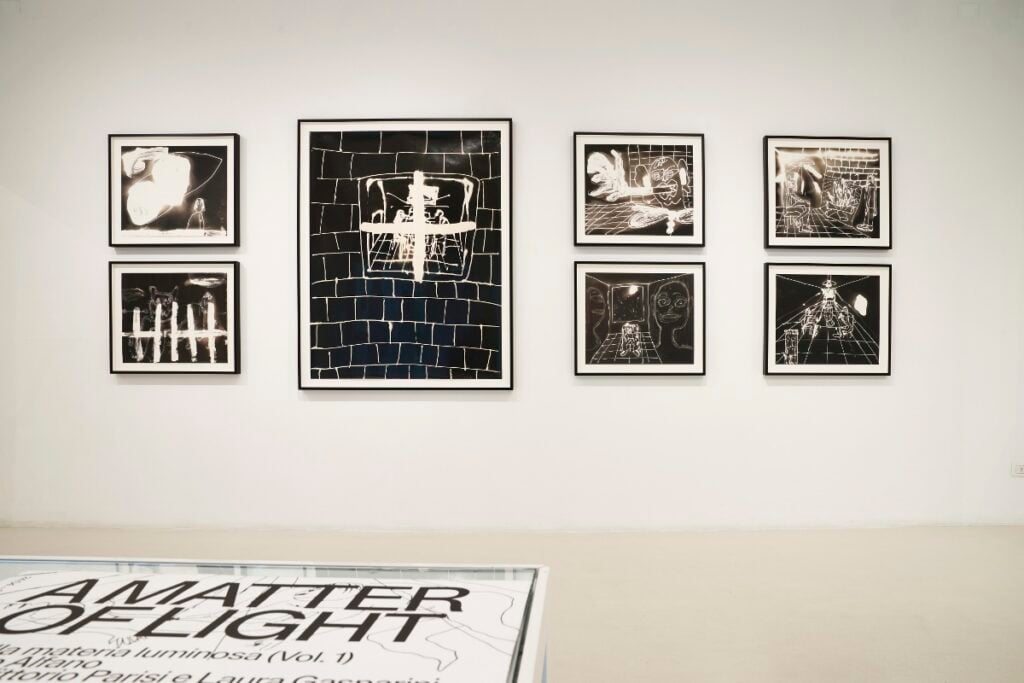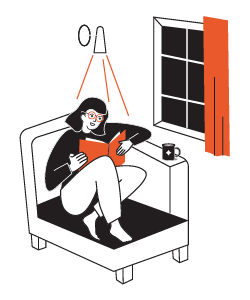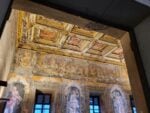Roberto Alfano – A Matter of Light

Studio sulla materia luminosa (Vol. 1)
Comunicato stampa
In recent years, Roberto Alfano's research has primarily focused on enhancing the creative
process within artistic practice, with an intention of indefiniteness seen as a symbol of
freedom of expression.
In "A MATTER OF LIGHT: Studio sulla materia luminosa (Vol. 1)," Alfano renews his
intentions by hybridizing darkroom photographic printing techniques with painting,
creating a new dimension of research that broadens the expressive possibilities within his
artistic practice.
The presentation of this journey represents the first chapter of an ongoing work that focuses
on research and experimentation, also understood in their alchemical sense, from a
persistent perspective that harkens back to the early photographic experiments of the 19th
century.
With this exhibition, SPAZIOC21 reaffirms its role as a design laboratory where photography
—understood as a medium—recovers its experimental dimension and metalinguistic
qualities.
Accompanying texts for the exhibition by Vittorio Parisi and Laura Gasparini. The exhibition
is enhanced by the release of a limited edition publication created in collaboration with
Luca Zoccola.
Technical partner: Bellinifoto.
Text by Vittorio Parisi
“A galaxy in the gel of the universe”
In his 1989 essay "Photography and Liquid Intelligence," Canadian photographer Jeff Wall
reflects on the impending development of digital technologies that would soon alter "the
historical consciousness of the medium." According to Wall, this alteration stems from what
we might call a paradigm shift in photography, where the "liquid intelligence" of its origins—
represented by the essential use of water and emulsions in the analog process—suddenly
becomes "dry" through electronics. This paradigm shift is both historical and ontological
because, in the transition from analog to digital—and thus from emulsion to sensor, from
photosensitive material to pixel, from droplet to glitch—the essence of photography has
changed from its original vocation.
As American art historian Kaja Silverman argues in her work "The Miracle of Analogy," the
photographic image originates as "an analogy, rather than a representation or a reference."
In other words, the photographic image does not exist to represent or designate any
referent; it is not us who "take," "make," or "capture" it, but rather it emerges from the world
and reveals something about it to us. It is "an image that arrives from the future and lands in
the present." If this primacy of analogy is lost in the transition to digital, it is because
"analogy is also the fluid in which [the image] develops": it is through that fluid that the light
captured by the shutter transfers onto the material and takes on a discernible form, allowing
the world to emerge and re-introduce itself.
Roberto Alfano is a painter. Like every painter, his work consists concretely of manipulating
fluids and fixing them onto a surface in order to bring forth something from the world and
to the world. Although the outcome of two different mediums and processes, the essence of
painting shares with that of photography the principle of analogy: both a photograph and a
painting are analogical in that they resemble the world from which they originate, while at
the same time allowing us to transcend that same slice of the world, revealing its infinite
meanings and connections in analogous forms.
But what happens when, with an alchemist's spark, the painter decides to set aside his
chosen fluids and manipulate those of photography instead? What occurs when it is not
pigments, but light—what Roberto Alfano prefers to call "luminous matter"—that becomes
the ally of the painter in escorting an image from the future to the present?
The works that comprise "A Matter of Light" are the result of this liquid alliance between
painting and photography, through which the latter returns to what Wall refers to as the
"archaic nature of water, of liquid chemical agents," which "connects photography to its
past, to time."
Whether they are black-and-white or color works, in large or small formats, the images that
emerge from these studies come from a world that is both created and immortalized. Like in
"traditional" photography, they indeed preserve the luminous memory of the time and
place where Roberto Alfano acted on the photosensitive paper. However, the difference lies
in the fact that this memory has been redirected by the artist towards forms and motifs
typical of his imagination and style: from atomized bodies to survivors of an after-party, from
growling dogs to crying children, from windows to gates, from meteors to galaxies.
Refined over the past three years, the technique employed by Alfano allows for the delivery
of a pure liquid movement, rich in light, on the photographic support, existing
simultaneously as both a pictorial and photographic act.
Text by Laura Gasparini
“The colors without name: a brief historical overview up to Roberto Alfano’s experiments”.
The image gradually takes shape in the darkness of a large room that, for the occasion, has
been transformed into a photographic laboratory. First, the outlines appear, almost like a
drawing; then, the areas of light and shadow, and finally, the details. This is how the
photographic image emerges, taking its final form thanks to the skilled manipulation of the
author, who exposes or underexposes certain parts of the image to achieve the desired
contrast, carefully controls the development process, refines the tonal values, and finally
fixes it with sodium thiosulfate. It is an image, a drawing created with photosensitive
materials, that evokes both the magic of photography and the power of imagination. The
aesthetics of photography are expressed not only through the mechanical instruments—
such as the camera and optics—but also through the different types of photographic paper
and the expert craftsmanship of the photographer.
Henry Fox Talbot presented the invention of the negative/positive photographic process in
1841 at the Royal Society in London. Talbot had previously used the camera lucida, a device
equipped with a prism that projects a scene onto a sheet of paper, allowing the user to
trace it with a pencil. In this case, the syntax depended on the artist’s hand—whether more or
less skilled—and the texture of the paper surface. He later experimented with the same
reproduction method using the camera obscura.
In 1844, reflecting on the images produced by the pinhole camera or the optics of the
camera obscura, Talbot wrote in A Brief Historical Sketch of the Invention of the Art of
Photography (1844): ‘ […]this led me to reflect on the inimitable beauty of the images
produced by nature’s painting, which the camera’s lens projects onto paper at its focal
point: enchanted images, creations of an instant, destined to disappear just as quickly."
Talbot emphasized the importance of form, contour, and the defining lines of an image.
What this new reproduction technique could not yet do, however, was accurately reproduce
color. With photography, Talbot demonstrated that photographic images were a perfect
imprint of reality", created not by an artist’s hand but directly by nature’s own pencil. This
idea led him to produce the first-ever photobook, The Pencil on Nature (1844–46), featuring
24 photographic plates accompanied by his commentary. What is extraordinary, at least in
the writer’s view, is how Talbot had already, by 1841, identified and described key aesthetic
values of the photographic process- not just the richness of detail, the precise contours of
subjects, and the clarity of form, but also the ability ‘to manipulate and control’ the actions
of developing and fixing chemicals to achieve different tonal effects. These tones translated
the colors of nature into black and white.
To fully grasp the significance of Talbot’s discovery—or rather, his invention—particularly in
terms of the aesthetics of his photographic process on paper, we must take a step back in
time. At the end of the 18th century, drawing became a speculative activity, a fundamental
tool for knowledge, and it was enriched with new techniques. Not only the mark itself but
also the paper—specifically, the uncoated white paper (unlike today’s industrially bleached
paper)—became a key element in the grammar and syntax of artistic language. This aesthetic
would later characterize photography on paper. The blank sheet, thanks to its format, was
crucial in defining the boundaries of figuration and, later, of the photographic image.
Talbot also analyzed the role of light and how its intensity affected the aesthetic outcome of
an image: "An image, stripped of the ideas that accompany it and considered only in its
essential nature, is nothing more than a sequence or variation of brighter lights projected
onto one area of paper, and deeper shadows on another. Now, light, where it is present, can
exert an action, and this, under certain conditions, is sufficient to cause changes in material
bodies [...] on the paper. In that case, there must surely be some effect bearing a general
resemblance to the cause that produced it, so that the varied scene of light and shadow
could leave behind its image or imprint, more intense or weaker in different areas of the
paper depending on the strength or weakness of the light that acted there."
The "effect" is the element in which different tonal values suggest a sensation or thought,
even when using only a roughly sketched drawing, as seen in certain paintings. The
technique of effect was a widely appreciated aesthetic concept in both French and English
culture. Success depended on the ability to focus attention on the subject, often reinforced
by drawing and detail. In academic settings, the technique of effect was also linked to that
of the sketch and the ébauche (preliminary study), both of which could be easily achieved
using Talbot’s process.
The matte-surfaced paper, sensitized with a silver nitrate solution and then exposed to
sunlight, produced images with more or less intense reddish-brown tones. To modify this
tonality, chemical toning processes were applied, such as gold or selenium toning, which
resulted in a brown-purple coloration. The tonal richness was influenced by numerous
variables: the paper sizing, different dilutions in fixing and washing, and the length of
exposure and toning time. Poor fixing, whether due to insufficient duration or the use of
exhausted hyposulfite, tended to cause fading and a mauve coloration—a hue highly
appreciated in the fashion world during the Victorian era. Photographs fixed with potassium
bromide, on the other hand, developed a yellowish tone in the highlights and whites. Other
photographic prints displayed slate-gray tones in the shadows, grays, and blacks, while in
the lighter areas, they turned gray-green or yellow-brown.
Regarding these new, unnamed color palettes, Talbot foresaw new expressive possibilities
and stated: "I remember that many people, when photogenic drawing was first discussed,
claimed that it was almost an affront to art, a mechanical process replacing talent and
experience. [...] By simply varying the fixing process, one can impart almost any tone to the
image, warm or cool, and achieve either a bright or dark effect [...]. All of this falls under the
artist’s ability to combine and control [...], and if, in the course of these experiments, he
nolens volens should inadvertently become a chemist or an optician, I am sure that this
alliance between science and art would prove beneficial to the advancement of both."
Through experimentation, an artistic syntax emerges, from Talbot to Hill and Adamson,
reaching French artists and photographers such as Charles Nègre, Gustave Le Gray, and
Henri Le Secq, who significantly contributed to refining photographic techniques and
aesthetics. These experiments also gave rise to off-camera photography, which flourished in
Europe through Surrealism and beyond.
After World War I, photography changed, exploring new paths that focused on the aesthetic
quality of photosensitive materials while rejecting optical realism. Christian Schad, Man Ray,
and László Moholy-Nagy were among the first to create abstract images in the darkroom:
shadographs (1920), rayographs (1921), photograms (1922), and solarizations—these last
ones resulting from technical accidents in the darkroom, where images were exposed to
light before being fixed. Such experiments had already been practiced by Christian Schad
in the Dadaist context as early as 1918.
Photography thus abandoned technological apparatus (camera, enlarger, optics, etc.), as
well as the theme of objective vision, moving closer to a ‘painterly approach’ that freed the
artist's imagination and sensitivity. This was not merely a rejection of rapidly advancing
technology but an effort to liberate the artist’s inner vision through light, movement, and
inner impulse, capturing it on photographic paper. Photography was not just an extension
of vision but also of the artist’s inner-world.
Within the Bauhaus movement, Moholy-Nagy demonstrated through his photograms that
gesture and light were fundamental elements in compositions achieved using photographic
materials—distinct from Man Ray's approach, which involved three-dimensional objects.
These works pointed to a ‘new vision’, unexplored paths of research that, in Italy, were
pursued by Luigi Veronesi and Bruno Di Bello, following Nino Migliori’s linguistic
experiments in photographic coding (such as his Ossidazioni and Pirogrammi from 1948).
More recently, young artists such as Angelo Candiano in Situazioni (2002-2017) and
Semiosi, Silvio Wolf in Horizon (2006), and Fabio Sandri in Interno Ulteriore (2016) have
explored the chromatic possibilities of film and photographic paper, using photosensitive
material to "precipitate" (in the artist's words) our experiences and perceptions into
‘unnamed colors’ characteristic of photographic paper.
One artist who has delved into the materiality of photography and grasped its aesthetic
allure is Alison Rossiter. After years behind the camera, she abandoned it, fascinated by the
study of 19th-century photographic papers from the MoMA collections in New York.
Recognizing the potential of that aesthetic and language, she began acquiring expired
photographic paper, experimenting with its tones and nuances, inspired by American
Abstract Expressionism, where pure color emerges through form rather than, for example,
the brushstroke. In her experiments , Rossiter (2020) explored oxidation effects, varying light
exposures, and different fixing times. Time itself becomes the creator of these images, she
asserts, revealing its presence through the allure of unnamed colors.
Among the many experimental approaches to photosensitive materials, an essential
contribution is Picasso’s light painting experiments from 1949. These are extraordinary and
fascinating examples of how the artist used light. In a dark room, Picasso created thirty light
drawings using a small lamp, while his friend, photographer Gjon Mili, captured them with
his camera. What is striking is not only the experimental technique but also the freedom of
movement expressed in space—a spontaneous act, unconstrained by aesthetic rules, tools,
or technical limitations. These drawings, made with light and in space, have come down to
us thanks to photosensitive materials, recorded by the camera, and later made visible to a
wider audience.
Roberto Alfano's research, presented in the exhibition A Matter of Light, draws from many of
these aesthetic inspirations, developing new experiments with photosensitive material that
open up unexplored creative paths. After all, in photography, as Walter Benjamin clearly
states:
"The decisive element in photography remains the photographer's relationship with their
technique."
A technique refined through experimentation, subverted processes, and even errors—
ultimately leading to a unique and unmistakable form of artistic expression.
Bio
Roberto Alfano, Lodi, 1981. His interest for art began in the first half of the nineties, when he
was first captivated by the graffiti writing scene. In time this interest would develop into an
obsessive passion for drawing and painting.
His primary sources of inspiration are tied to contemporary underground culture, to Art-Brut
and to post-impressionist and expressionist painting.
Beside his productions and exhibitions, the artist has specialized in leading experiential-
artistic laboratories addressing groups of people with disabilities or living social and
psycho-physical distress.
Lately Roberto Alfano’s research is focused on underlining the value of the creative process
in the artistic practice as being a symbol of freedom of expression.



